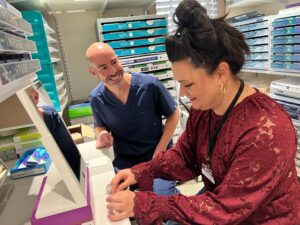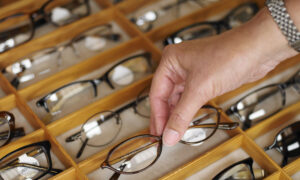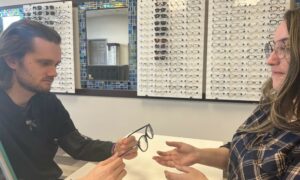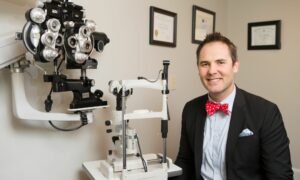
Dr. Zingaro with his practice’s contact lens technician, who trains patients in all things contacts. He says that having a well-trained team to support you makes a huge difference in growing the contact lens portion of your practice.
By Vince Zingaro, OD
March 1, 2023
In football, success depends on the relationship between the coaching staff and the players. Talent alone will be limited on the field without a coach who can motivate, physically prepare and organize the players to coordinate a true team effort.
Likewise, the most inspiring, strategic and well-intentioned coach will be limited by the talent they have available on the field. When the full potential of the players combines with the exceptional leadership of the coaching staff, the team functions at the highest level.
The team in your office is no different, especially in terms of improving the patient experience. The staff in any office is vital to a successful contact-lens practice. Here are three ways you can train your staff to team up with you to better serve contact-lens patients and grow this portion of your business.
Other Articles to Explore
Don’t Limit Patients to “Glasses-Only” or “Contacts-Only”
When you put patients into a box, you’re limiting the solutions to their visual problems. Training your technician or front-desk staff to ask each patient if they’re interested in contact lenses is a great way to increase the number of contact-lens patients in your office. It’s simple, but can lead to big results. This is especially true in the presbyopic population, where many patients think they can’t wear contacts lenses anymore.
In our office, we’ve seen a nearly 10 percent increase in multifocal contact lens revenue annually over the last several years. Much of this increase can be attributed to our technicians simply asking the patient if they’ve ever considered wearing contact lenses.
Ask the Right Questions
Whether you’ve been practicing optometry for three years or three decades, you know that when you ask a patient about their contact-lens experience, you’re more than likely to hear one word: “fine.” As tempting as it is to leave well enough alone and plow through your busy schedule, it’s important to confirm that the patient is really satisfied with their lenses.
We’ve trained our technicians to ask two important questions to contact lens patients: “Do your contacts ever dry out at the end of the day?” and “Does your vision seem worse at the end of the day?” Knowing this information before I see my patient helps me to decide which direction to go with contacts. I may need a toric lens if nighttime driving is impaired or it may be a good opportunity to prescribe a daily disposable to a patient experiencing end-of-day dryness.
It’s estimated that about 25 percent of our patients admit to some end-of-day discomfort or decreased vision after initially reporting no complaints with their contacts. Providing solutions to these contact-lens problems helps prevent the patient from dropping out of their lenses altogether.
Always Assume an Annual Supply
We fit approximately 80 percent of our patients in daily disposable contacts. Not only do they tend to be more comfortable and healthier for the patient, but patients are most compliant in this modality. We further improve compliance by striving to get patients an annual supply of contact lenses when they purchase from the practice. This starts in the exam room when I explain to the patient that they’re approved for an annual supply. The next step is crucial in handing the patient off to a staff member.
I like to repeat what I told the patient in the exam room in front of staff member, so everyone is on the same page. I review the lens I prescribed for the patient and explain that they’re approved for enough contacts to last them until their next visit. This makes it easier for the staff member to facilitate the transaction with the patient. Our staff is trained to know the rebates available to the patient and is trained to price match, if needed, on an annual supply to retain the contact-lens sales within the practice.
Our staff is also trained to show each patient how much they are saving with vision insurance and manufacturer’s rebates. Writing this out for the patient makes it easier to recognize the value of an annual supply of contacts. We aim to be around 70 percent, or greater, in annual supplies of lenses and have been successful in this metric by training our staff to write out the savings to show the patient. Annual supplies of lenses are important to retain contact-lens sales in your office, but also to protect the patient from buying their lenses online from questionable outlets.
Bottom Line: These are simple steps that can be easily passed onto your staff to support your contact-lens patients and business. It’s important to keep reminding staff to stay on top of these points as they can become so simple that they’re sometimes overlooked.
On the football field, complacency can mean the difference between winning and losing. In your office, it can mean the difference between gaining or losing a contact-lens patient.
 Vince Zingaro, OD, practices at MyEyeDr. locations in Chester Springs and Lancaster, Penn. To contact him: Drvincezingaro@gmail.com
Vince Zingaro, OD, practices at MyEyeDr. locations in Chester Springs and Lancaster, Penn. To contact him: Drvincezingaro@gmail.com



























